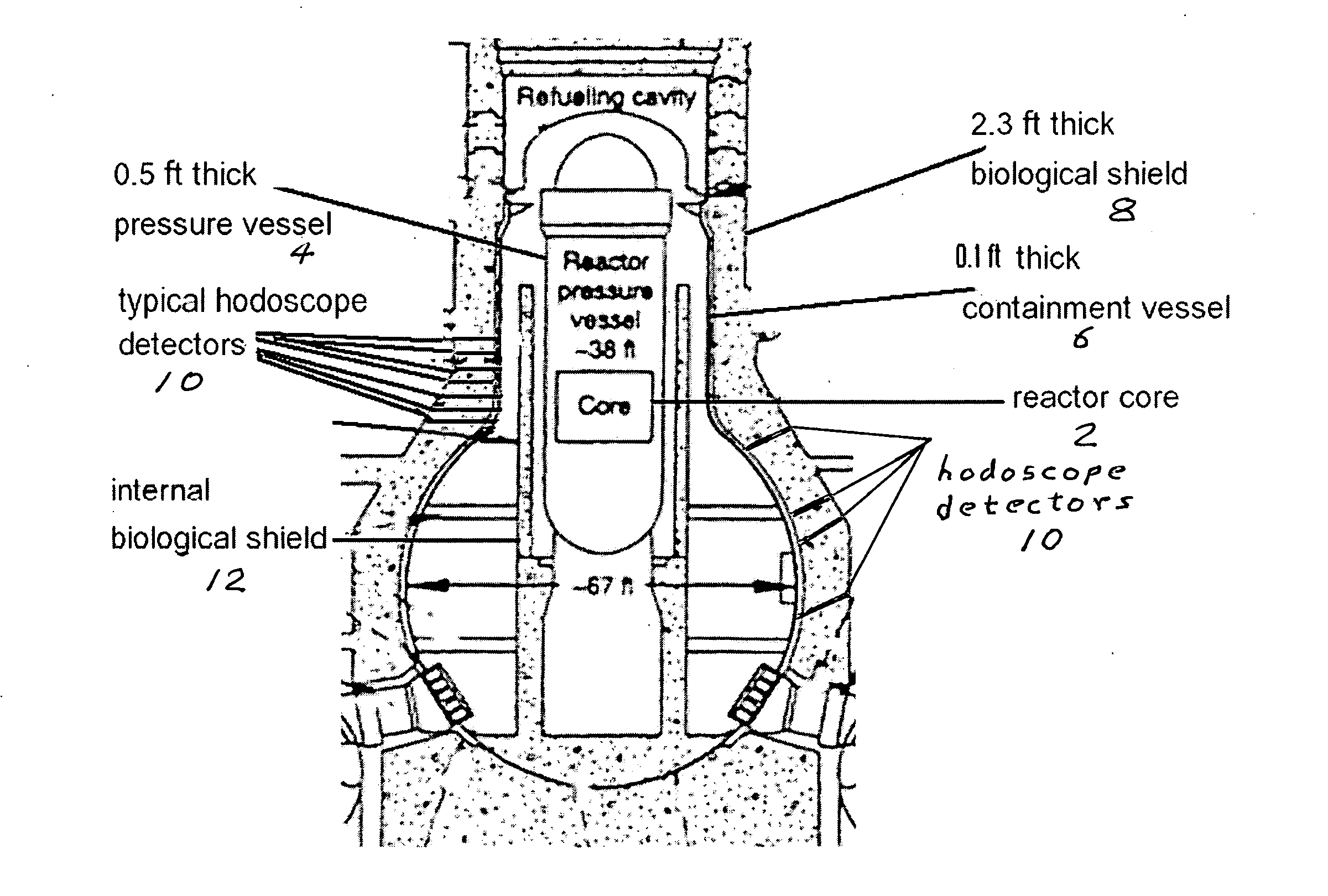Radiation-monitoring diagnostic hodoscope system for nuclear-power reactors
a nuclear-power reactor and diagnostic hodoscope technology, applied in the direction of instruments, greenhouse gas reduction, optical radiation measurement, etc., can solve the problems of huge financial costs for cleanup and power-generation displacement, reactor destruction, and evacuation of surrounding population, and achieve the effect of overcompensating inherent flux-dependent fuel-concentration sensitivity reduction
- Summary
- Abstract
- Description
- Claims
- Application Information
AI Technical Summary
Benefits of technology
Problems solved by technology
Method used
Image
Examples
first embodiment
Preferred First Embodiment
Single-Channel Hodoscope
[0077]FIGS. 2A and 2B show some essential features of two versions (13 in FIGS. 2A and 15 in FIG. 2B) of a single-channel hodoscope of the present invention. The FIG. 2A version includes a thick, long tungsten (lead or steel could be substituted) collimating tube having a 2-cm channel drilled through the center of the tube.
[0078]At the end of the tube is installed an off-the-shelf gamma scintillation detector, such as Model 943-37 available from Fluke Biomedical with offices in Everett, Wash. This model is 5 cm in diameter and includes a 5-cm long sodium iodide (Nap crystal 14, a photomultiplier tube assembly 16 and a preamplifier 18. Mounted in front of the detector is a thin lead and / or cadmium filter, the position of which is shown at 20, used to block low-energy neutrons and gamma-ray background. This channel limits the field of view of this specific hodoscope to about 4 degrees. In the unit shown in FIG. 2B, the collimating chan...
second preferred embodiment
Embedded Hodoscopes
[0082]FIG. 3 is a side view of a typical embedded hodoscope detector 20 of the present invention. A slotted collimating channel 22, with a typical diameter of 5 cm is drilled through the 40-centimeter steel external reactor containment vessel 6 and the 320-centimeter concrete biological shield 8 and the internal biological shield 12. A shielding sleeve—made of lead, steel, or tungsten—may be formed around the channel 22. A radiation barrier 24 preferably made of tungsten, lead or steel that shields a sodium-iodide (thallium-activated) scintillation crystal 26. A cavity adjacent to crystal 26 contains electronic preamplifiers or other electronics 28. This embodiment with its thalium-activated sodium-iodide crystal does not necessarily need refrigerant. The collimating channel 22 could be a pre-existing instrument access hole or a newly drilled or enlarged hole through the concrete biological radiation shield. In some embodiments, channel 22 would not be drilled thr...
third preferred embodiment
Movable Hodoscope Array
[0087]FIG. 4 which is a side view of a movable hodoscope detector array section 30 consisting of hodoscopes of the present invention arranged in a vertical array. Each hodoscope comprises a collimating channel 36 with a typical diameter of 1.3 cm. This collimating channel 36 serves to limit the entry cone for radiation which impinges on the detector inserted at the end of that channel. This collimating function is crucial for reducing the entry of extraneous background radiation that emanates from portions of the pressure vessel or reactor outside the angular view of any specific collimating channel.
[0088]A major aspect of this invention is the multichannel use of a multiplicity (array) 30 of such mobile collimating detectors, in order that triangulation could take place, enabling computer-aided reconstruction of the reactor fuel and coolant configuration that is responsible for the detected radiation source.
[0089]Lead, tungsten, or steel shielding effectively...
PUM
 Login to View More
Login to View More Abstract
Description
Claims
Application Information
 Login to View More
Login to View More - R&D
- Intellectual Property
- Life Sciences
- Materials
- Tech Scout
- Unparalleled Data Quality
- Higher Quality Content
- 60% Fewer Hallucinations
Browse by: Latest US Patents, China's latest patents, Technical Efficacy Thesaurus, Application Domain, Technology Topic, Popular Technical Reports.
© 2025 PatSnap. All rights reserved.Legal|Privacy policy|Modern Slavery Act Transparency Statement|Sitemap|About US| Contact US: help@patsnap.com



